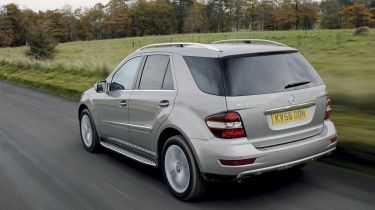Mercedes ML320 CDI Sport
Is nip and tuck enough to keep the M-Class in contention?
Bosses at Mercedes seem to be following that old adage: if it isn’t broken, then don’t fix it. The current M-Class is such a well rounded performer, the firm decided only minor modifications were required to take on the latest crop of premium SUVs.
In fact, you’ll need to look really closely to spot the changes. At the front, there are subtly modified headlamps, a slightly bigger grille and reprofiled bumpers.
Elsewhere you’ll find new door mirrors, while the tail-lamps get a smoked lens tint. Casual observers will be hard pressed to identify the newcomer over the outgoing model. That’s no bad thing, though, as the Merc has real presence and is much more imposing than the X5.
Climb aboard and there are even fewer changes. The main differences are the addition of a new multifunction steering wheel and more heavily bolstered front seats. Happily, the driver gets the same commanding view of the road as before, while the use of a steering column-mounted gearshift and foot-operated parking brake frees up space for two useful large cup-holders between the front seats.
Sadly, the revised car retains too many cheap plastics, meaning the Merc loses out to the BMW for cabin ambience. There’s plenty of space, though, with passengers in the rear getting generous leg and headroom.
Used - available now

2023 Tesla
Model Y Premium
39,591 milesAutomaticElectric
Cash £22,300
2021 Land Rover
Range Rover Evoque
29,135 milesAutomaticPetrol1.5L
Cash £21,800
2023 Hyundai
Kona Electric
67,359 milesAutomaticElectric
Cash £11,200
2022 Toyota
C-HR
34,646 milesAutomaticPetrol1.8L
Cash £16,900Hit a button on the key fob and the electrically powered tailgate glides open to reveal an impressive 833 litres of carrying capacity – the BMW manages only 620 litres. Fold the rear bench flat and the M-Class serves up a van-like 2,050 litres.
While it has the upper hand for practicality, the Mercedes lags behind the X5 at the test track. Its 221bhp 3.0-litre V6 oil-burner is smooth, torquey and restful at a cruise, yet lacks the knock-out punch of its rival. In isolation, the 0-60mph time of 8.8 seconds looks impressive; compare the M-Class to the BMW, and it trails by more than two seconds. Not only is it slower, it’s thirstier, too. We only managed a disappointing 22.6mpg, compared to the 26.1mpg return of the rapid X5.
On the road, the Mercedes claws back some of the lost ground. Its smooth seven-speed automatic gearbox helps disguise the performance shortfall, while direct steering and strong grip mean it is capable when cornering.
Our test car was fitted with optional air-suspension, which gives you the choice of sport or comfort modes. Select the former and body roll is reduced. It still fails to match the agility of the X5, though, and ride comfort is also badly compromised.
With no more than cosmetic tweaks carried out, the M-Class has done little to modernise in the face of ever stiffer competition. Thankfully, the quality of engineering behind the German firm’s SUV means it’s still up to the challenge.
Details
Price: £44,285
Model tested: Mercedes ML320 CDI Sport
Chart position: 2
WHY: A round of revisions has given the M-Class sharper styling and more equipment.
Economy
Look at the spec lists, and there are some important differences between these two cars, despite their similar prices. For instance, the Mercedes has leather trim as standard, but it will cost you an extra £1,510 on the BMW. The M-Class also comes with Bluetooth phone connectivity, which adds a further £540 to the price of the X5. Include the extra £260 required to match the heated seats included as standard in the Mercedes, and you can see how much more you need to spend to get the same spec BMW. Yet apart from insurance, the M-Class loses out in every other respect, making it more costly to run here.
Environment
in the eco stakes, the Merc is disappointing. Not only do official CO2 emissions of 254g/km put it in the top tax band, but our 22.6mpg fuel returns were poor.



